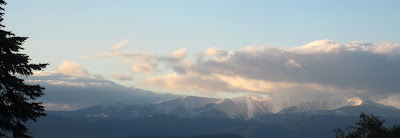Things to do in October, in and around Butte America (southwest Montana).
Feel the Earth tilt away from the sun: the Beauty of Early Snow
The snowline begins high up on the ridges of the Continental Divide that ring our little city. Here, on the Highland Mountains:
Or, seen a recent hunt in the sagebrush hills of the Big Hole River area, high on the ridges of the Pioneer Mountains:
Soon, the snowline is below 8,000 feet on the East Ridge:
Soon it will be in our front yard!
Feel the Earth turn on its axis: Sunrise, Sunset
The sky glows in the pre-dawn:
And, while hiking back to the truck after a late afternoon hunt, the full moon rises over the sagebrush hills:
Hunting Scenes: Hunting is about more than filling the freezer with meat
I've seen and heard several rattlesnakes over the course of the year. Usually, they slither under a rock or into thick sagebrush before I can even pull my camera out. Walking along a rocky ridge in the late afternoon, with the air temperature c. 50 deg F, I thought it was too cold for snakes to be active. But a flash of color at my feet followed by a buzzing rattle proved me wrong. Though the Old One was safe in its den, I could see enough "skin" for this photo:
Near the rattler, I came upon this interesting monument--perhaps a cairn built by some Basque sheepherder a hundred years ago. Or maybe it marked the place where he was struck by a rattlesnake:
If the hunting is slow, there are often interesting rock formations:
Water is scarce on the high desert. Groves of aspen are a sign of moisture:
Let's hike over that way. Sure enough, local ranchers have corralled some of that water in stock tanks for cattle (and also as a benefit to the wild critters):
A river does run through it--the Big Hole River, fed by high-country snow melt, lined with cottonwood trees and ranchers' hayfields:
My view was from atop these sloping cliffs:
Just downriver I could see Browne's Bridge, the historic first commercial crossing, originally a wood structure but replaced in the early 20th century with this marvelous iron truss bridge:
While hunting pronghorn antelope with my friend Matt Hamon, this herd of elk (bull w/ cows) rose up from "nowhere", watched us awhile, and left us wondering how elk could hide in the wide-open landscape:
Of course, while hunting elk, I have seen relatively few--and none were standing & looking back at me! Most often, I see elk "sign", such as these fresh droppings (we tell novice hunters, "You can tell how fresh they are by tasting them".):
Each year, deer and elk grow a new set of antlers in the spring and shed them in winter. In forested areas, mice and other rodents usually make quick work of shed antlers. On the dry prairie, however, they last much longer. I like to photograph them and leave them for the critters. Here's a shed from a young bull elk, a "spike":
And several more from young, fork-horned mule deer bucks:
When I come home from hunting, MollyTheDog always brings her moose, shaking it & growling, then setting it at my feet. What's worse than a dog that gloats? (She learned the name of this toy the first time Jan told her--probably because it looks like the real moose skull that decorates our parlor, and she has that Border Collie affinity for language.):
Visit Yellowstone National Park
We try to make a visit each year in early October. The crowds have thinned out, critters are in rut, and the wolves are active. On this trip we saw black bears and a grizzly (too far for photos) but alas no wolves. We did of course see lots of hoofed browsers, especially buffalo:
Buffalo, like much of the YNP experience, help us to slow down and be in the moment. Sometimes the buffalo do this forcefully--I think this herd was part of the "Occupy Yellowstone" movement:
Unlike the elk I hunt, those in the Park are habituated to humans. They're still "wild", they just don't see humans as predators. They were most common around the Mammoth Park Headquarters, probably because they are fairly safe from wolves there:
This young elk bull was all alone, probably driven off by a dominant herd bull. Note how his antlers and tawny hide blend into the sagebrush and dry grass:
Maybe we should introduce him to this elk cow and her two calves (one might be a yearling, her calf from 1&1/2 years ago). She seems lonely:
This raven seemed lonely too. Or, more likely, spotted as a "soft touch" for a handout:
YNP was originally set aside in 1872 as a "pleasuring ground" primarily for its geological wonders. Only later did Americans come to appreciate and enjoy wildlife watching. Each visit, we are awed by the geology of the Mammoth area, including the terraces:
Strange colors & textures:
Basalt columns along the Gardner River (aka "Sheepeater Cliffs"):
And waterfalls (Tower Falls shown here):
What's this I see through the steam rising from a hot spring along the Gardner River?:
Of course, it's the "Boiling River"--a must stop for a good, relaxing soak at the end of a happy day:
Happy Autumn! (and for our friends in the southern hemisphere, Happy Spring!)
Foraging with Bears
4 weeks ago




























































